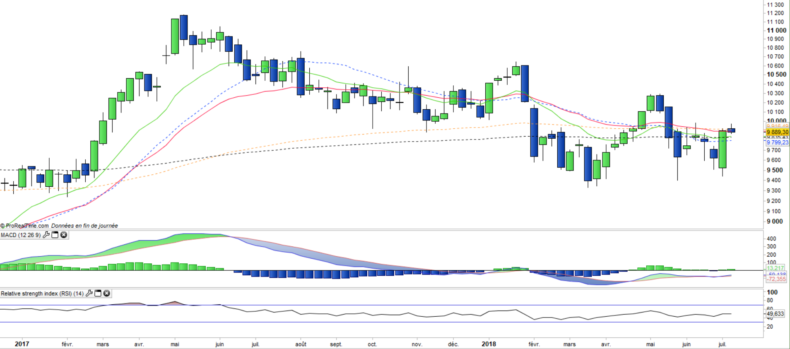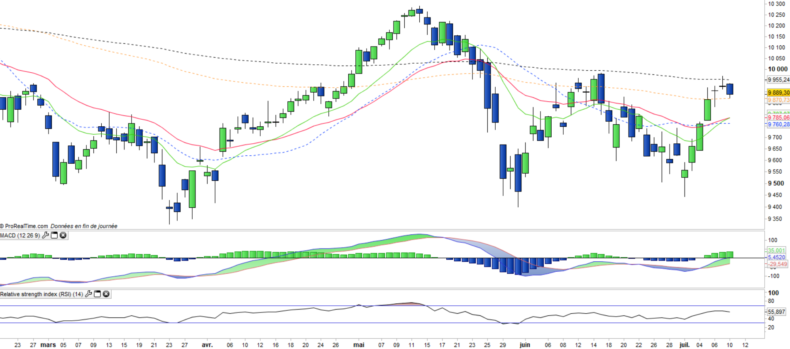Lyxor ETF Ibex35 - LYXIB - 11/07/2018
Short Term strategy: Neutral (50%) / Trend +
Long Term strategy: Positive (55%) / Trend =
pour accéder à nos achats / ventes sur les indices
Characteristics of the ETF
ETF Lyxib (Lyxor) replicates the Spanish index, which is composed of the country's top 35 stocks weighted according to the market capitalization and adjusted according to the liquidity of each company included in the index.
The expenses of the ETF are 0.3%, while the AUM reach around 975M €. Replication is direct (physical) and there is a dividend distribution on a half-yearly basis.
Alternative ETFS: DXIBD (DX-Deutsche Bank), EWP (iShares in USD)
Latest developments
The IBEX35 rose by 7.4% in 2017, which is lower than the STOXX600 (10.6%), because of the willing for independence of Catalonia, the most important region of Spain from the economic point of view with 16% of population and 20% of national GDP.
In 2018 the Spanish index loses so far 1.5% but is recovering after the fall of the Rajoy government and the weak coalition currently in power led by the Socialist Sanchez. The rise in Italian rates after the populist victory had an effect on Spanish contagion rates, which added pressure to the Spanish index. For the moment, however, politics seems to be taking a back seat, especially as the resumption of negotiations with Catalonia has resumed this week, which leaves some hope for a longer-term federal solution.
The problems of Latin America, and particularly the falling currencies could have an impact on some large Spanish groups strongly established in the area as Telefonica or Iberdrola.
Index & components
This index, like that of Italy, has the particularity of being very overweight in financials, which represent more than a third (33.3%) of its composition (against around 20% for stoxx600), including Banco Santander, BBVA and Caixa Bank, while alongside industry (11.6%), consumer goods represent also a significant weight (12.2%) which is mainly due to Inditex which weighs € 85bn of market capitalization, as well as utilities (14.5%), which include Iberdrola, Ferrovial and Abertis.
The 10 largest capitalizations account for almost two thirds of the index, in addition to the companies already named they also include telecom giant Telefonica as well as the oil group Repsol.
The IBEX was under pressure in 2016 due to the bad behavior of the European banking sector, and the political problems that left Spain in uncertainty for many months and without government, while its macroeconomic situation improved significantly but suffered from its strong exposure to Latin America under pressure for 2 years, which is linked in particular to Brazil and Venezuela. However, the Brazilian economy seems to be coming out of recession while Argentina, Colombia and Peru benefit so far from "pro-business" governments.
In 2017, Spain saw its GDP grow by 3.1% keeping the same pace as in 2016 despite the Catologna issue, a figure well above that of the euro area which reached 2.5% in 2017, and continues at the same pace in 2018 despite new political turbulences. The fourth largest economy in the euro area, has just registered its heighteenth consecutive quarter of growth since late 2013, after a descent into hell began in 2008 in the aftermath of the real estate and financial crisis.
Two factors specific to Spain made possible the sharp rise in GDP confirmed in 2017: the recovery of the labor market, whereas between 2013 and the end of 2016, the unemployment rate went from 27% to 18% and 1, 2 million jobs have been created. The second explanation concerns the profitability of companies which has become one of the best in Europe, which can be explained by the reorientation of Spanish companies towards exports after the collapse of the domestic market.
Weekly data
The weekly chart shows an attempt to reverse the trend in the medium term, which is reflected in a positive figure of last week's bullish engulfing. Prices are now on the brink of crossing the EMA26 upward, while the oscillators are turning positively. Confirmation is required to validate the bullish pattern, but the turnaround seems on track.
Daily data
On the daily chart, it can be seen that a double-bottom figure has been formed, but it is now necessary to cross the neck line which corresponds at the same time to the EMA200 days, currently at 9955 pts. This crossing, confirmed at the close, would give a confirmation signal of the short-term double-bottom as well as the medium-term bullish reversal.
ETF Objective
LYXIB is a UCITS ETF, listed in EUR, which seeks to replicate the IBEX 35 index (35 spanish companies)
Characteristics
| Inception date | 19/01/2006 |
| Expense ratio | 0,30% |
| Issuer | Lyxor |
| Benchmark | Indice IBEX 35 Net Return |
| Code/Ticker | LYXIB |
| ISIN | FR0010251744 |
| Currency | € |
| Exchange | Euronext Paris |
| Assets Under Management | 975 M€ |
| Replication Method | Direct (Physical) |
| PEA (France) | Yes |
| SRD (France) | Yes |
| Dividend | distribution |
| Currency risk | No |
| Number of Holdings | 35 |
| Risk | 4/5 |
Country Breakdown
| Spain | 96% |
| United Kingdom | 3% |
| Luxemburg | 1% |
Sector Breakdown
| Financials | 33% |
| Utilities | 14% |
| Industrials | 12% |
| Consumer discretionary | 12% |
| Telecom services | 9% |
| Energy | 7% |
| Information Technology | 6% |
| Others | 7% |
Top Ten Holdings
| Banco Santander | 15% |
| Inditex | 11% |
| Banco Bilbao | 8% |
| Telefonica | 8% |
| Iberdrola | 8% |
| Amadeus IT | 6% |
| Repsol | 5% |
| Caixa Bank | 4% |
| Intl Consolidated Airline | 3% |
| Aena | 3% |


